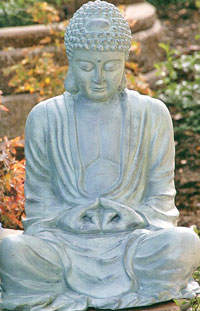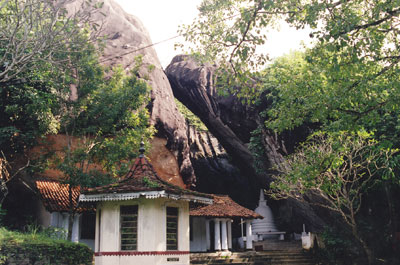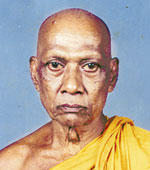Today is Nikini Pasalosvaka Poya
|
Bodhisatva Siddhartha's renunciation and the end of search
S.W. Lewke Bandara
 Renunciation: The universally accepted tradition in the
Buddhist World about the great renunciation of Prince Siddhartha and His
search for the capability for the realisation of truth (Kim Kusala
Gawesi) leading up to the Enlightenment are the most celebrated aspects
of the life of the Bodhisatwa. Renunciation: The universally accepted tradition in the
Buddhist World about the great renunciation of Prince Siddhartha and His
search for the capability for the realisation of truth (Kim Kusala
Gawesi) leading up to the Enlightenment are the most celebrated aspects
of the life of the Bodhisatwa.
It is traditionally accepted that the appearance of the Four Portends
(Sathara Pera Nimithi) is the catalyst of this momentous event in human
history.
However, the Suttas and other sources compel the discerning student
to look into these events in an objective and critical point of view, in
the spirit of the Kalama Sutta, that would throw penetrative light to
understand the true perspective regarding these events.
Tradition has it that King Suddhodana had imposed an injunction that
the young Prince should be totally kept in the dark about the phenomenon
of Jara (decay) Vyadhi (disease), Marana (death) and the abandonment of
lay life - Sramana, lest the early prediction about Siddhartha
renouncing the lay life would bear fruit.
Despite this precaution it appears that when the Bodhisatta was being
driven in His chariot to the pleasure garden He encountered an old man,
a sick man, a corpse and a hermit. He ascertained from His charioteer
about these phenomena and learnt that the first three encounters were
inexorable conditions of life and also about the abandonment of lay
life.
The Bodhisattva with His deep sensitivity, extra ordinary intellect
and profound learning would not have not known about the phenomena of
Jara, Vyadhi, Marana and the abandonment of lay life even if these
encounters were physically kept away from him.
Therefore these four portends should be perceived by us to whom this
account is offered in the light of the Buddha's teaching: "Friends I do
proclaim that in this very fathom long body with its perceptions and
consciousness is the world, the world's arising, the world's cessation
and the path leading to the world's cessation. (Anguttara Nikaya 11.48)
Thus the chariot may be symbolically perceived as the human body, the
journey to the pleasure garden as human beings' eternal quest for
happiness, the charioteer as the human intellect and the Bodhisatta as
the flowering of wisdom.
Thus the story of the four portends represents the fact that these
phenomena of decay, decease and death were seen with penetrative wisdom
resulting in the purity of mind-sra-mana, the fourth portend.
The Ariya Pariyeshana Sutta of the Majjima Nikaya appears to be an
autobiographical account of Siddhartha and here He ponders thus:
"Subject as I am to the phenomena of birth this is decay and death, is
behoves Me that I embark in the search for that bliss free from birth,
disease, decay and death".
The actual event of renunciation is popularly and dramatically
portrayed as the Bodhisattva receiving the tidings about the birth of
His son and thereafter leaving the household in the middle of the night
unknown the father and His wife and taking a glimpse of His new born
child sleeping with its mother in her bed chamber.
However, the first person account in the Ariya Pariyeshana Sutta of
the renouncing of the household life by Siddhartha himself lends support
to a view regarding this event that is more in accord with reality and
with His sensitive and perceptive temperament.
Here He explains the difference between the pursuit of the outward
journey in search of worldly goods and pleasure which is called Anariya
Pariyeshana as against the noble pursuit the Ariya Pariyeshana or the
inward journey, The Bodhisatta states."
Monks, having shed my childhood I reached the joyous days of the
first flush of youth radiant with raven tresses of hair. While my
sorrowing parents totally grief stricken and with tear laden faces wept
I sheared my head of hair and shaved by beard, donned the saffron robes
and relinquished my household life. Having embarked on life of a monk my
search for truth in pursuit of the immeasurable bliss commenced". (Ariya
Pariyeshana Sutta 1.3.6)
That the above version of the great renunciation accords more with
reality is borne out by the fact that none in the Royal Palace of
Suddhodana thereafter attempted to find Siddhartha's whereabouts.
Further, the fact that his wife Yasodhara followed a life of austerity
and solitude shorn of all finery and comforts supports the view that she
was well aware of this momentous step taken by her husband and was in
total approval thereof.
The manner in which the renunciation took place as set out in the
Ariya Pariyeshana Sutta lends support to the immediate cause of the
young Sakyan Prince abandoning His lay life as posited by certain Indian
Scholars like Ambadeckkar.
It is suggested that the young Prince Siddhartha who had assumed
leadership of the Sakyan clan had to intervene with the neighbouring
Koliya Kingdom regarding the waters of the Rohini River which was
pivotal to both kingdoms as a source of water vital for irrigation and
agriculture.
The obstruction by the Koliyas, the upper riparian owners of the
waters of the Rohini River was a constant irritant to the Sakyans.
Eventually the deliberations of the council of Sakyans led to a decision
to wage war against the Koliyas as a solution to this perennial problem.
Prince Siddhartha however, was vehemently opposed to this course of
action which He pointed out would lead to never ending strife and
worthless blood shed. Despite Siddhartha's dissent the Sakyans council's
decision to go to war against the Koliyas gained dominance.
In the result Siddhartha had to opt out of the participation in the
impending war to be waged against the Koliyas. According to the rules
and conventions of the Sakyans, a Sakyan leader going against the
decision of the council had to face drastic consequences, one of which
was to abandon the Sakyan Kingdom by renouncing the lay life and
embarking on the life of a mendicant.
Being of a highly sensitive nature from His childhood and averse to
any form of killing and violence Siddhartha with the full knowledge of
His wife and father accepted this offer readily. Thus is would appear
the socio political scenario prevailing at the time and the
uncompromising attitude of Siddhartha in not contributing to war and
violence seem to be the "Casus Belli" for His renunciation of the
household life.
After the Enlightenment several years later the Buddha Himself
directly intervened at this theatre of war when He spoke to the Sakyans
and Koliyas as the hostilities were about to begin over the waters of
the river Rohini.
The Buddha suggested the building of a dam at the point where the
rivers Rohini and Kethaki converged there by distributing the waters
equitably to both kingdoms.
Unprecedented in human history of effort and search in the pursuit of
truth is that embarked upon by Bodhisatta Siddhartha which is again
given in autobiographical detail in Ariya Pariyeshana Sutta and path of
self mortification "Dushkarak Kriya" in the Maha Sachchaka Sutta in the
Majjima Nikaya.
His first step in this path was His tutelage under Alarakalama.
Siddhartha followed His theory and practice in spirit and to the letter
and that is no time He mastered them that He was offered to co-manage
Alarakalama's monastery.
The Bodhisatta not only rejected this in toto but soon realised that
His teachings and practices was only conducive to dwell in the realm of
Nothingness (Akinchayathana) and in no way leads to detachment in the
Sansra and not conducive to enlightenment.
Siddhartha therefore totally disassociated Himself with Alarakalama's
teaching and practice and abandoned it absolutely.
Siddhartha's next station in His search was Uddakarama Putta whose
teaching and practice Siddhartha mastered to perfection.
However Siddhartha was totally disillusioned with his teaching which
ultimately would lead one towards the (realm of neither - perception
know - known perception) Nevasanna - Nasanna.
Therefore He totally rejected and abandoned this teaching and
practice as offering no solution to the ills of the world. However His
search continued and He practiced every form of self mortification
ranging from infliction of every possible form of torture pain and
deprivation to the body and starvation as a practice to tame and purify
the body and the mind with the assistance of the five groups of
ascetics.
|

Pilikuttuwa Raja Maha Vihara, a cave temple. Photograph : Janaka
Wettasngha |
The upshot of all this was that Siddhartha was reduced to literally
skin and bone and was hovering between life and death. Here too, the
Bodhisatta on His own perception realised the futility of this self
mortification" Attakilamathanu Yoga" and abandoned this practice much to
the disillusionment of His five colleagues who were dogmatically
attached to this practice as a method of self emancipation that they
deserted Siddhartha to fend for Himself.
Thus Siddhartha became totally isolated and walked alone abandoning
all knowledge theories and practices He had acquired in this search and
reached the Uruwella region and came upon the beautiful Senani Village
which He described thus "In my wandering I came upon the Senani Village
in the Uruwela Region.
Its tranquil woods the lovely flowing river with milky sandy banks
and bays, with the surrounding hamlet which could sustain me, attracted
me as ideal for pursuing of my inward journey" (Ariya Pariyeshana
Sutta). At the foot of the spreading shade of the Asatu Tree on the bank
of this river Siddhartha put an end to His search.
He abandoned without a trace all knowledge and all the authority
teachings and practices hitherto gained and started the journey against
the tide. (Patisotha Gami) and looked at the origin and the working of
the mind, body and thought (Yonisomanasikaraya). In the profound
solitude He was the Timeless Now (The Kshanaya) totally emancipated from
the dead past and the present and the unborn future all of which He
realised as a mere illusion.
In the timeless now has realised the Dhamma which is Akalika
(Transcending time) hitherto unheard by God or Man (Pubbesu Ananusuthesu
Dhammesu Dhevenawa Marenwa Brakmunawa Kenachiwa Lokasminthi). It is
therefore the only and the true revolution that ever occurred on human
history.
The Bodhisatta saw in His penetrative wisdom the cessation of
consciousness (Vinnana) which is the summation of human experience
inclusive of all defilements, all virtues, all Dhammas, all Adammas the
mind thought and every conceivable concept including the ego
simultaneously.
He saw the arising of perception (Sanna Samudaya) and in that very
arising its cessation (Sanna Nirodha).
Thus the very concept of a separate individual which is Sanna
(including the very concept of Siddhartha) was seen as a total delusion
created as a mental aberration brought about by craving in the operation
of the law of cause and effect.
He saw the Bhava (becoming) arising in the timeless now and in the
very arising in undergoes cessation, Vayadhamma Sankara.
This is seen as Bhava Nirodha. Thus Vinnanorodha and Loka Nirodha
namely the cessation of consciousness and the cessation of the world as
we see it is seen within this fathom long body.
All these arisings and cessations do not occur in a graduated time
frame but in the timeless now and in a flash of penetrative wisdom.
Therefore Enlightenment is seen in the Nirodha in the timeless now.
It is the lack of awareness that leads to the continuity of the Bhawa
resulting in Jathi, Jara, Vyadhi, Marana etc, etc.
The opening verses of Dhammapada set out the consequences of non
awareness "Appamado Amatha Padan, Pamado Machchuno Padan".
Total attention by the keeping of the eye of wisdom totally wake as
symbolised in the Animisalochana Pooja in the "Sath Sathiya" which is
attention in its purest will lead to ending of becoming and the ending
of the world.
Thus Enlightenment is the seen as Bhava, Vinnana and Loka Nirodha in
the timeless now. Which is the Buddhaothpada Kshanaya - the timeless now
where the Buddha or Enlightenment is born.
The Buddha is truly this Dhamma and cannot be seen by any creation of
the mind or by hand but arises in the timeless now to be seen by the
totally awakened. "So Dhamman Passathi So Man Passathi", said the
Buddha.
In this timeless now therefore Enlightenment is born and the
inseparable nexus of attachment between consciousness (Vinnana) and name
and form (Nama Rupa) is torn as under and totally severed.
Thalpitiya Raja Maha Vihara, Wadduwa
The temple which protected the Sacred Tooth Relic:
K. A. Perera, Wadduwa special correspondent
|

Ven. Talwatte Indrajothi Nayake Thera, the Chief Incumbent of
Daladawatta Raja Maha Vihara, Talpitiya, Wadduwa. |
WADDUWA: The 75th Annual "Dalada Perahara" of Thalpitiya Raja Maha
Vihara, Wadduwa, the only night pageant in Kalutara district will be
held on September 8. The historic Perahera will be held to commemorate
the event of the Sacred Tooth Relic which was kept for safety in the
temple.
During the Kotte period of Sri Lanka's history, when the Portuguese
came to this island and conquered the maritime regions (16th century),
the Portuguese plundered and razed most of the historic temples.
|

PERAHERA: Caparisoned tusker carrying the Relics casket parading
the streets during the perahera last year. Picture by K. A.
Perera, Wadduwa special correspondent |
When the Tooth Relic was taken away secretly, it was given full
protection at Thalpitiya Raja Maha Vihara, Wadduwa.
According to ancient chronicles, Ven. Aluwe Rewata Thera, the Present
Daladawatta Raja Maha Vihara was established and he passed away in 1879.
He had constructed a shrine room, residential quarters for bhikkhus. A
preaching hall for dhammadesana and rendered a valuable service to
propagate dhamma.
Ven. Pagoda Dhammaratana, who became the chief incumbent of the
temple commenced the famous "Dalada Perahera" in 1933. The Ven.
Madapatha Sumanajothi Thera added majestic glamour to the historical
perahera. To see large number of elephants parading the main roads in
Wadduwa is indeed a rare sight. It is also notable sight that hundreds
of Buddhist monks clad in saffron robes carrying the vatapatha march in
procession providing a bright an inspiring sight.
Troupes of traditional dancers accompanied by drummers take part in
the pageant. The perahera is scheduled to leave the temple of Thalpitiya
at 8.00 p.m. and will proceed along Goonetillake Road, Moronthuduwa
Road, Galle Road and turn off at Thalpitiya and return to the temple.
The peoplised bus service and private coach will provide special
night bus services from Panadura, Moronthuduwa and Kalutara to Wadduwa.
The perahera has been organised by the Youth Buddhist Society under the
guidance of Ven. Talwatte Indrajothi, the Chief incumbent of temple. |

